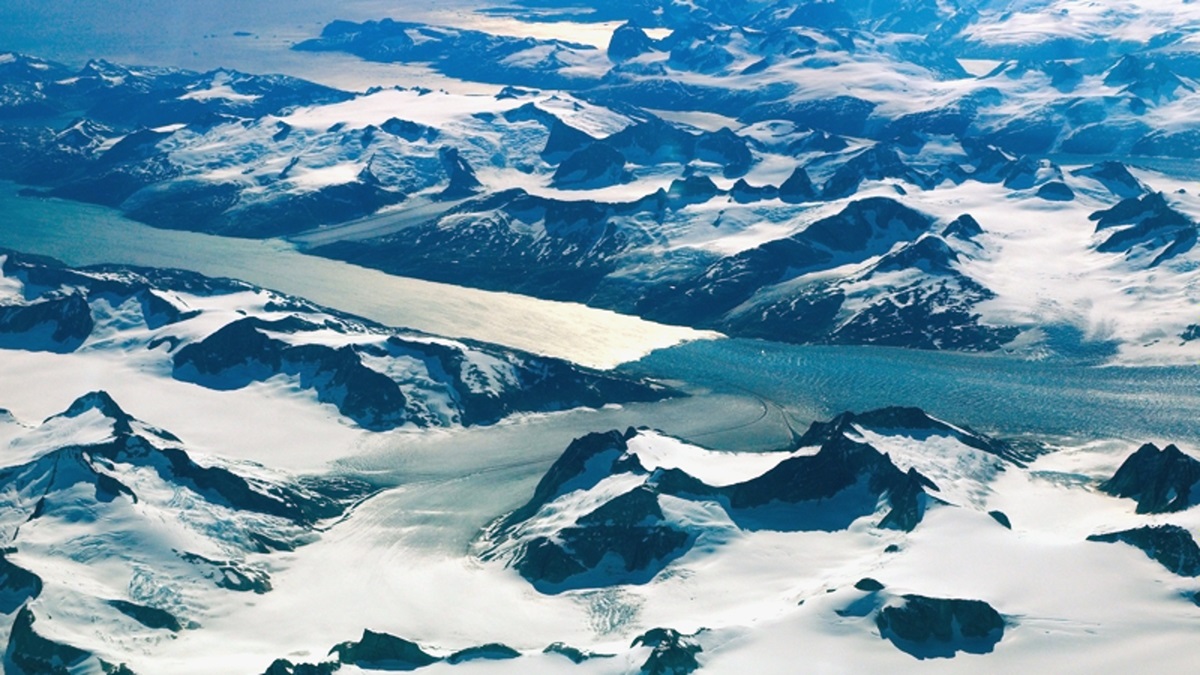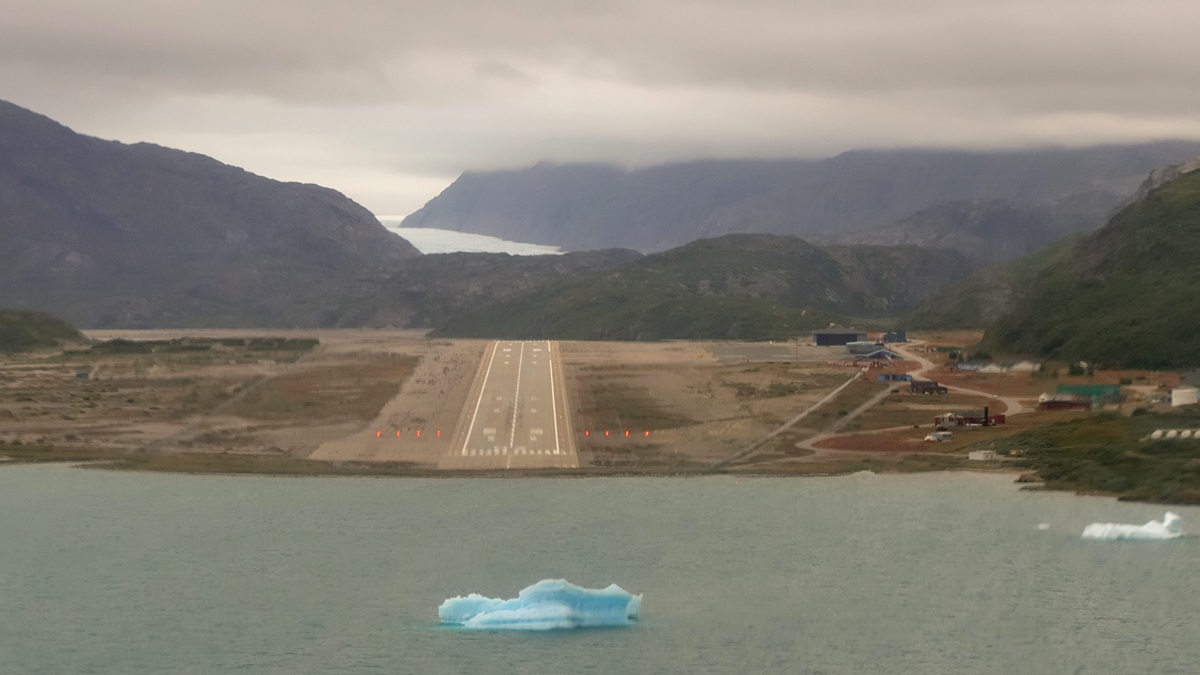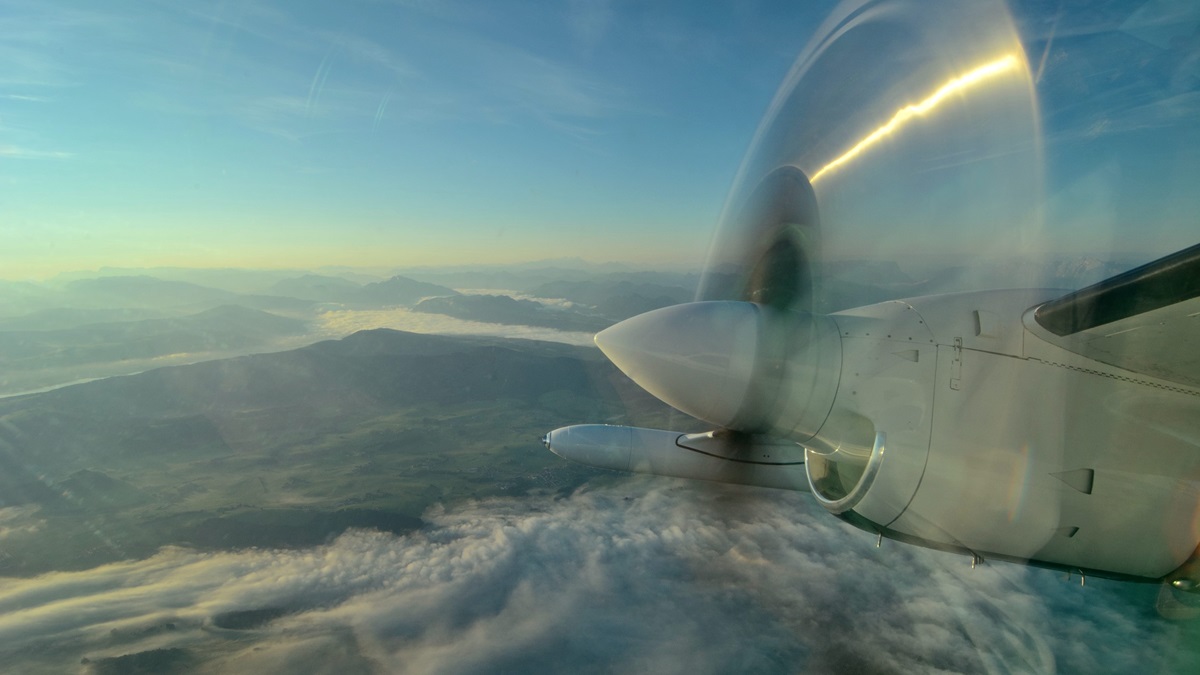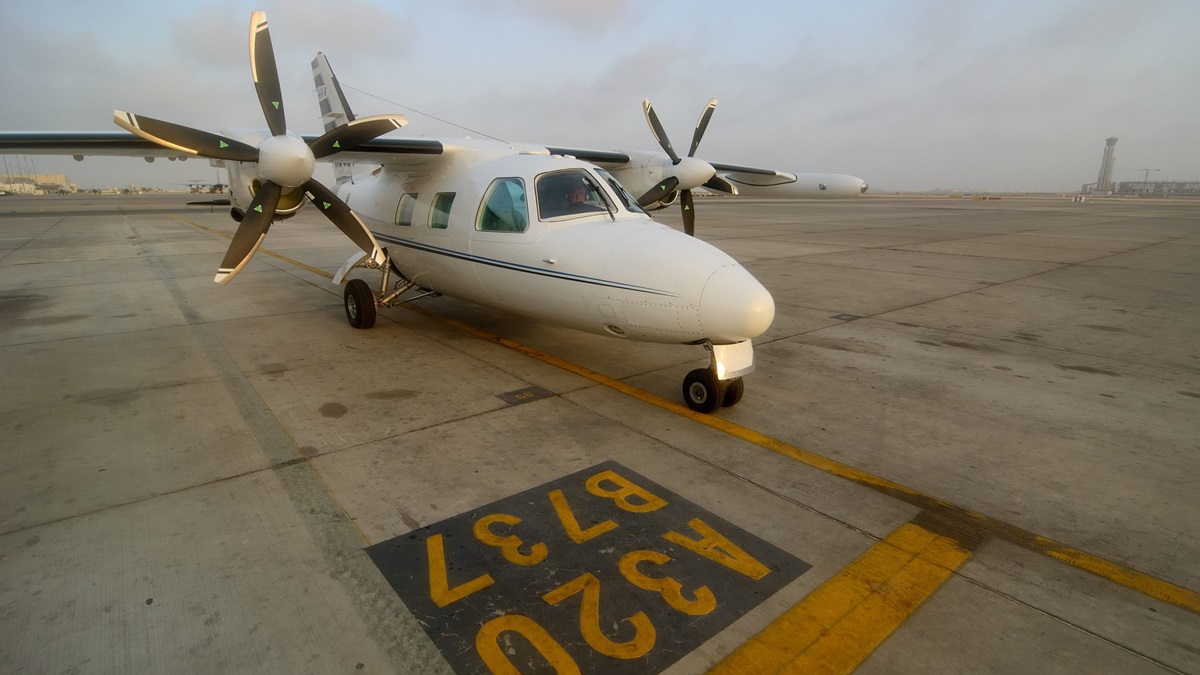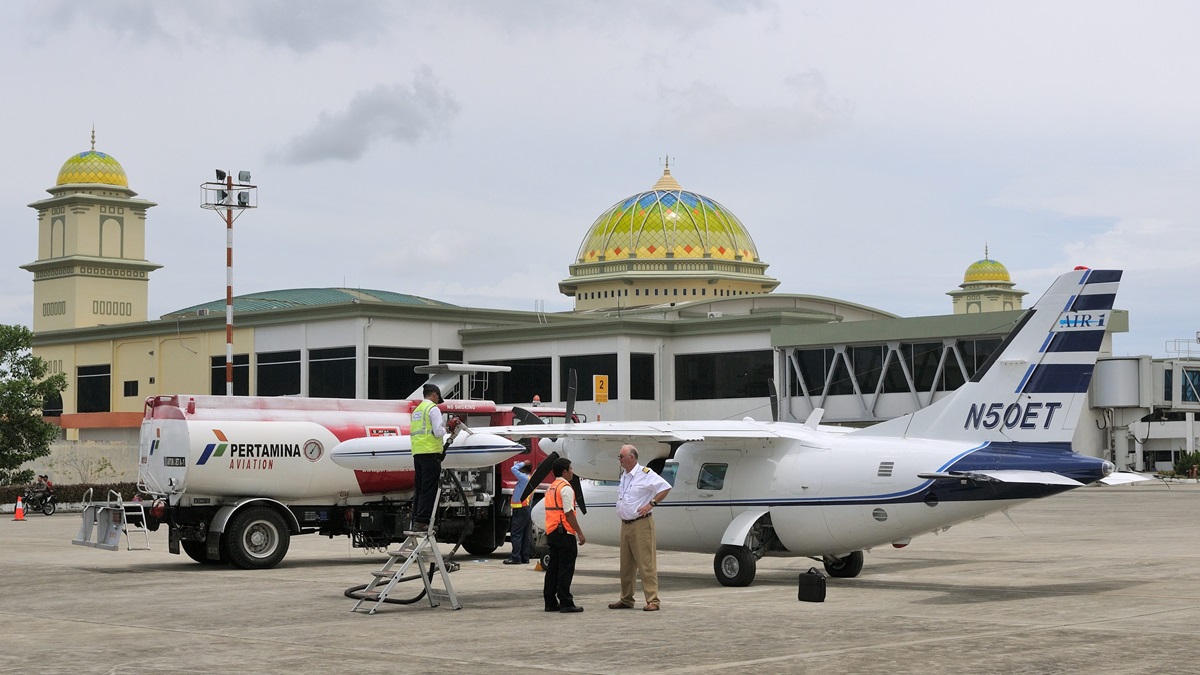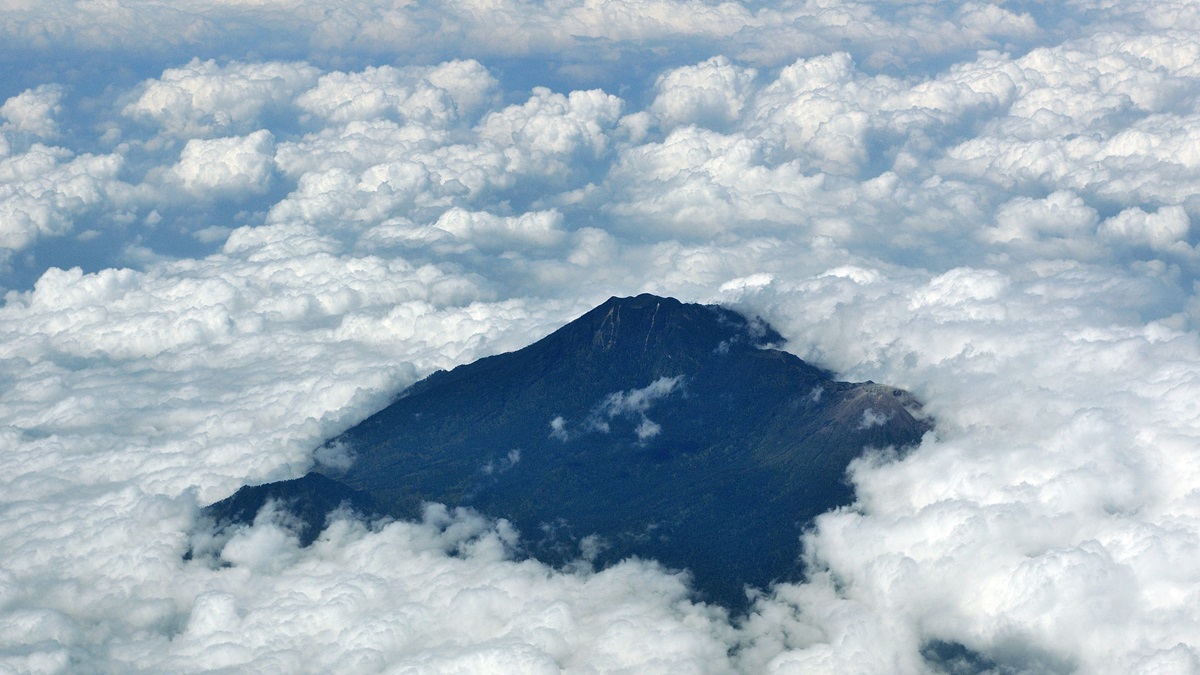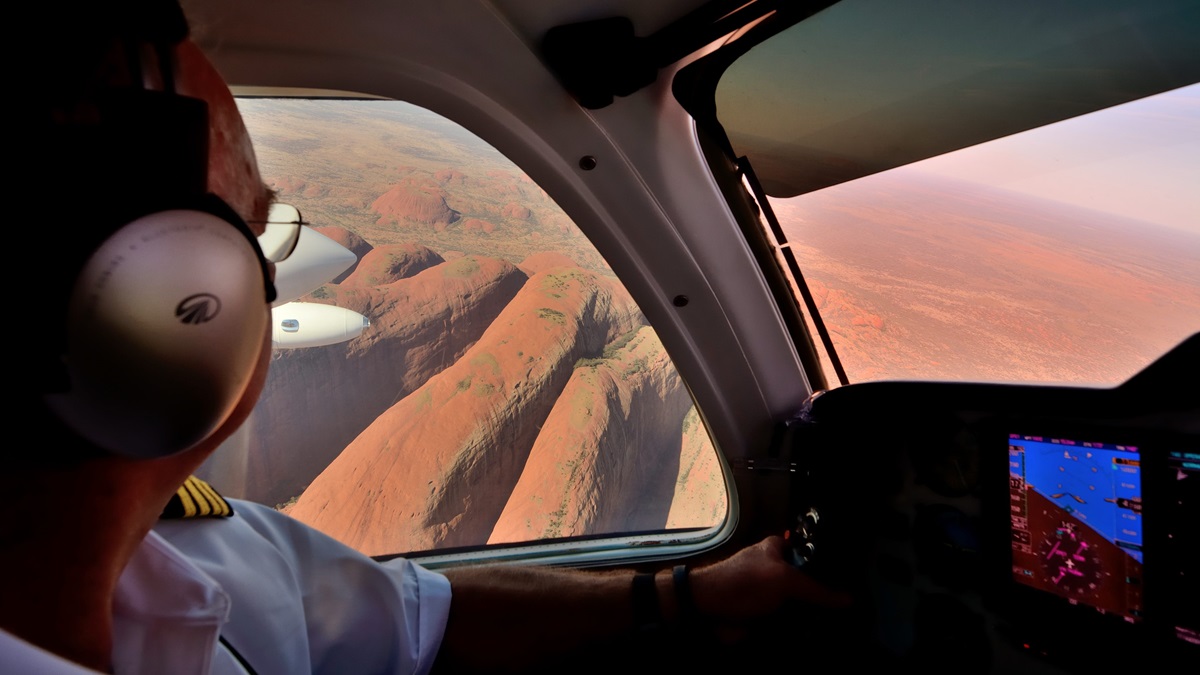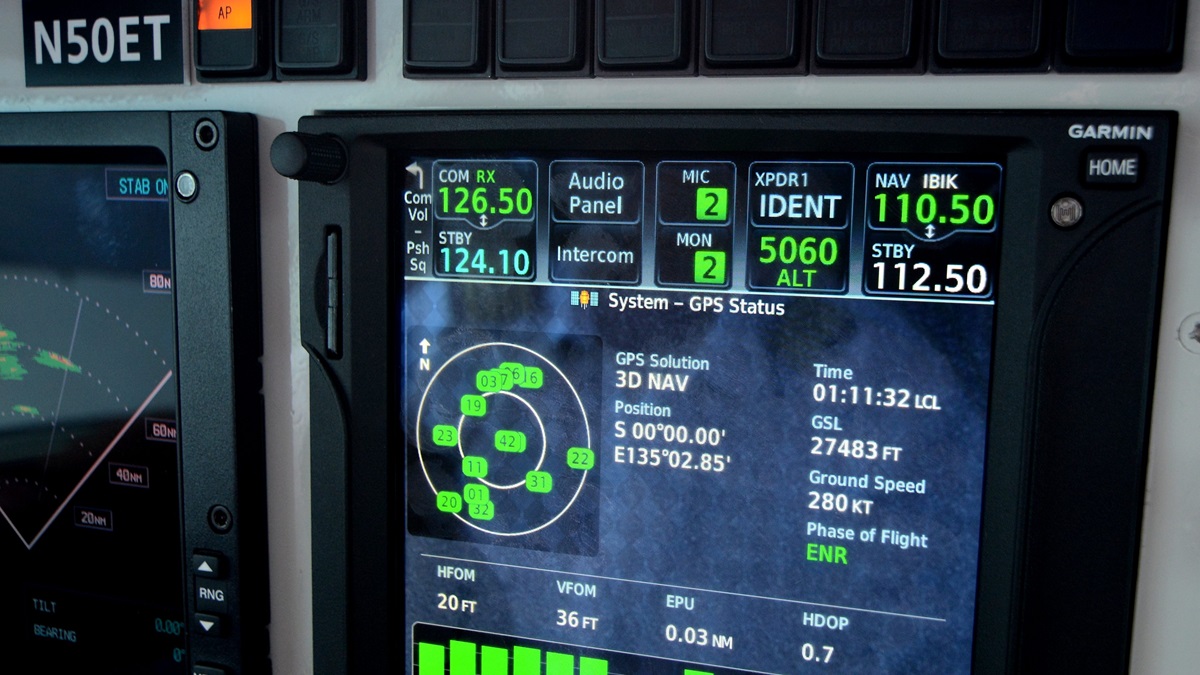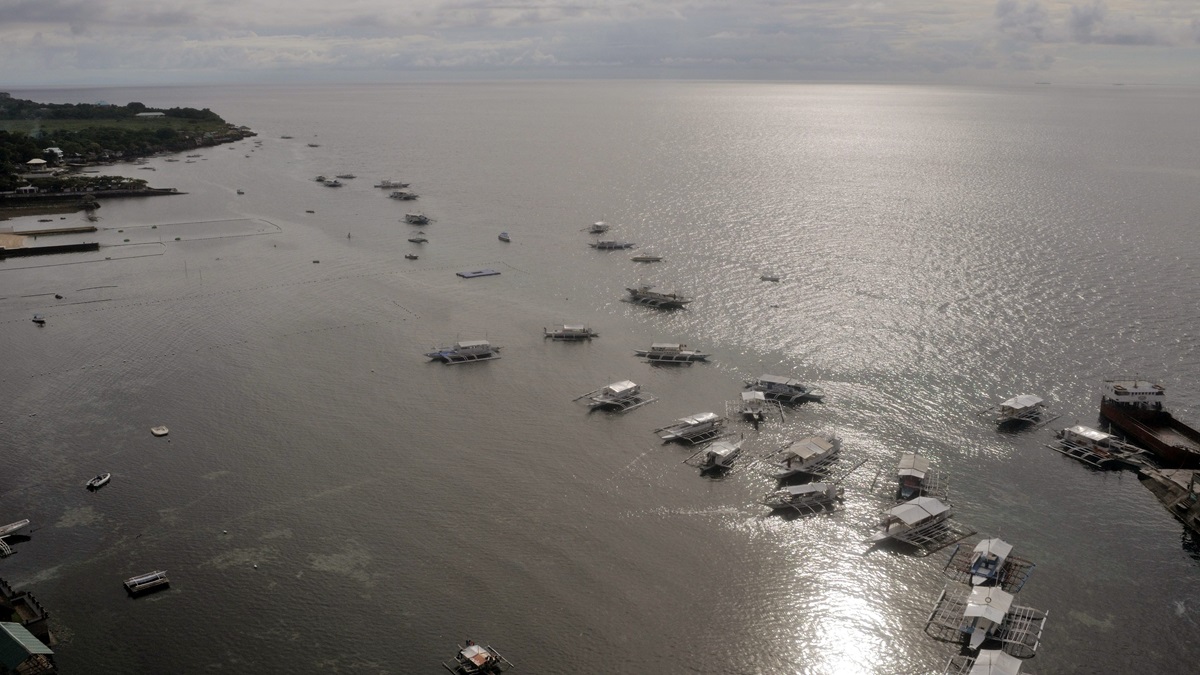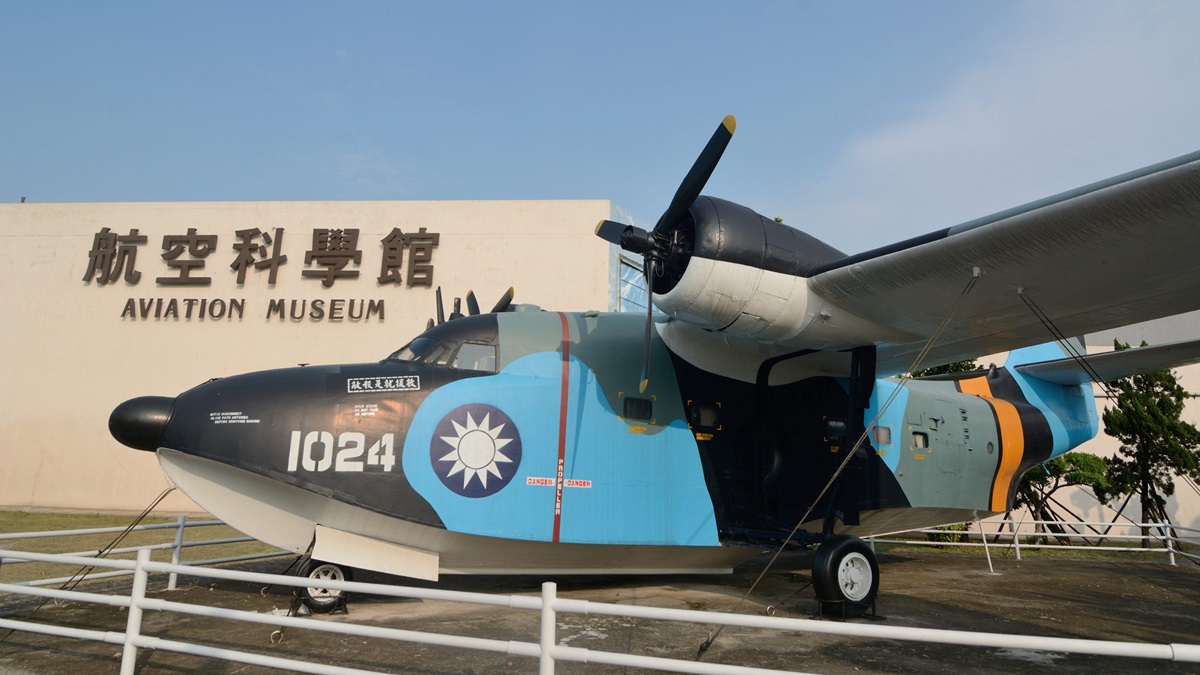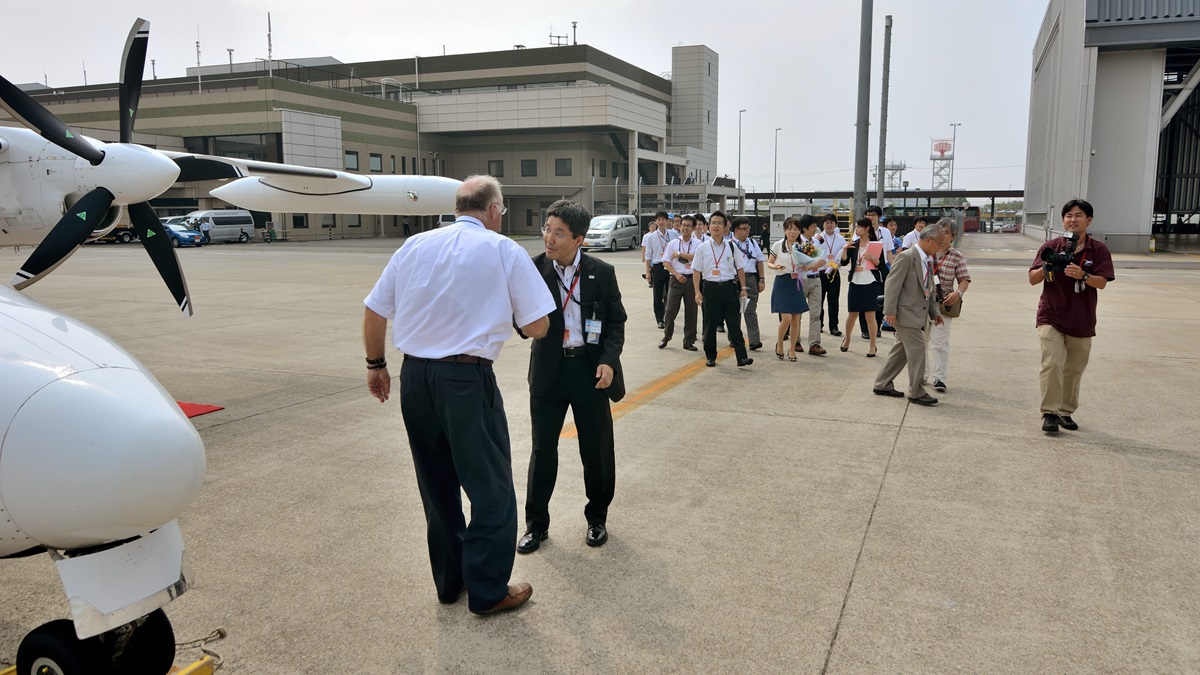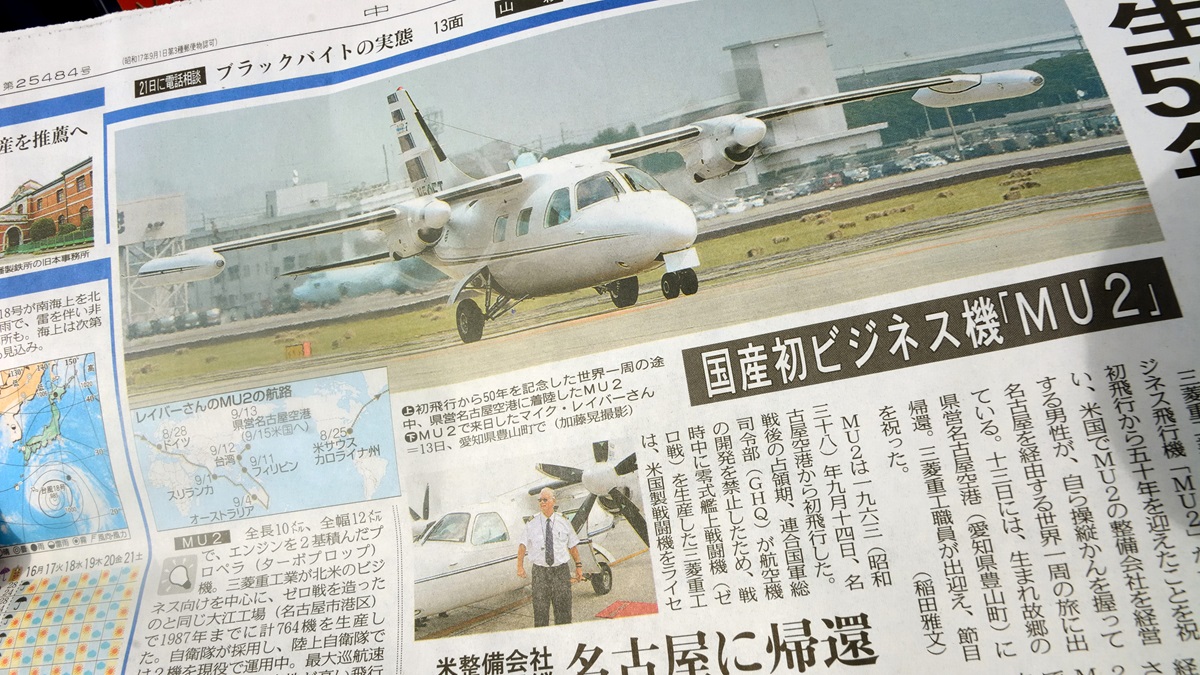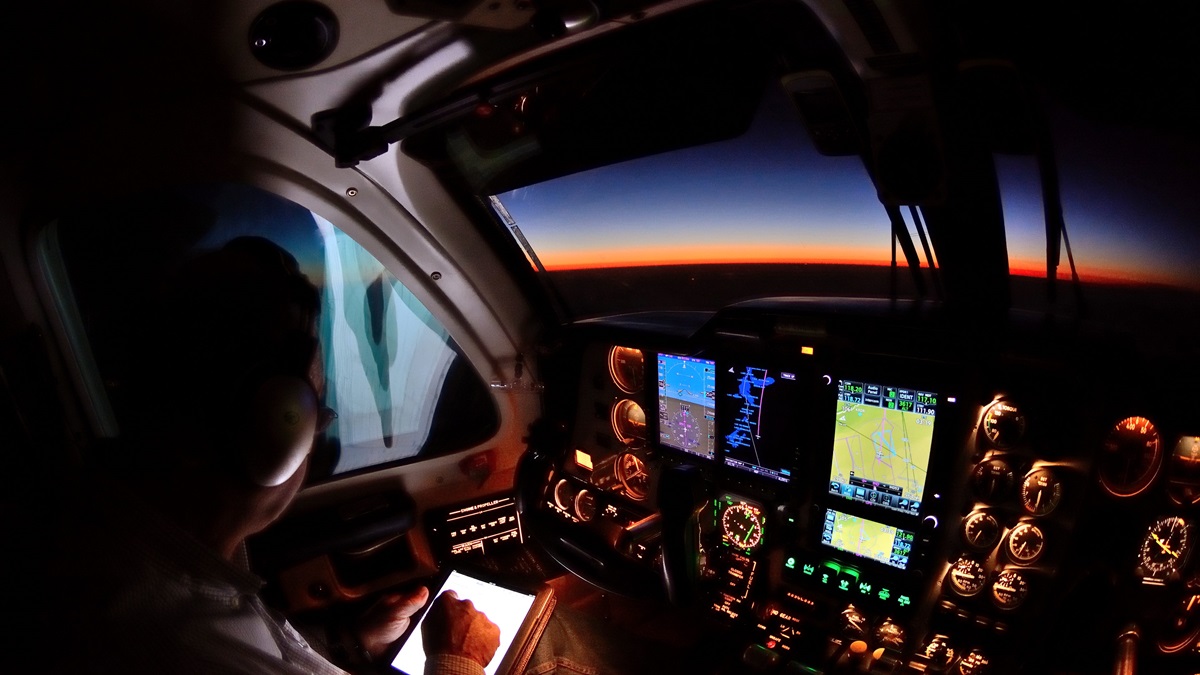Around the world in 25 days
30 legs, 26,568 nm, 98.1 hours
Mike Laver spent a year planning his around-the-world flight. A pilot and aviation businessman based in Aiken, South Carolina, he has flown Mitsubishi MU–2s for some 38 years, including 10 in his native Australia. He owns Air 1st Aviation Companies, Inc., an MU–2 dealer and service center, as well as an FBO. When Laver learned that September 14, 2013, was the fiftieth anniversary of the MU–2’s first flight, he decided to fly around the world—long on his bucket list—and be in its Nagoya, Japan, birthplace on the anniversary. I was invited to accompany him.
Ayers Rock
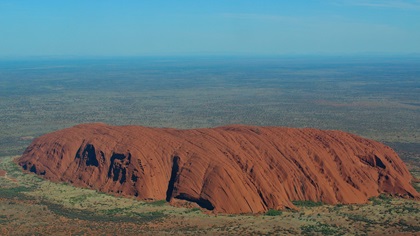
I never dreamed I would see this iconic Australian sandstone monolith, either from the ground or from the right seat of an MU–2 flying 3,000 feet above the sandy desert. On arrival we fly the published aerial tour of Ayers Rock and its counterpart, The Olgas—a dramatic formation of 36 large domed rocks, covering more than eight square miles—enjoying incredible views of both landmarks. A Gipps Skyvan and two helicopters, all flying tourists, share the circuit.
We’re not quite to the halfway point, and we’ve already experienced so much during 12,667 nautical miles and 11 days.
Planning
Planning is critical. Previous international flying showed Laver the benefit of using a handler, and after extensive research, he selected BaseOps. Leg lengths would be determined by the standard 360-gallon fuel capacity of N50ET, his 1973 MU–2B-25—no ferry tanks. Planning also included careful tracking of cruise performance and fuel burns at a variety of true airspeeds; long-range cruise would be required on a number of legs.
You must determine what visas you’ll need in advance, and obtain them. For me, it’s only two—Australia and Russia. The others are primarily transit visas arranged by our handler. A brief refueling stop, called a technical stop, at an international airport doesn’t require one at all—you don’t clear customs or immigration, and do not legally enter the country (think Edward Snowden in the Moscow airport). The only downside? A flight around the globe doesn’t add many stamps to your passport.
International flights also have political considerations. A coup in Egypt a month before our departure eliminated a planned stop there; even during the trip, we skirt war-torn Syria just days after the British decide not to intervene militarily—and just before the United States considers doing so.
Communications
“Five-Zero-Echo-Tango, I’m advised this is an around-the-world flight for the fiftieth anniversary of the aircraft,” a New York Center controller says on the first day of our journey. “That’s a true statement,” Laver replies. How did he know? “Have a wonderful flight,” the controller adds. What a great way to launch an adventure.
Beginning with Scottish Control and continuing through most of Europe and Asia, controllers assign frequencies as “One Two Seven Decimal Two Eight,” instead of “Point,” and they’re much more likely to use the proper phonetic pronunciation—by saying “tree” for “three” and “fife” for “five,” for example. Controllers in Turkey sign off with a distinctive “bye bye.” In Iraq the American influence is significant. Flying over Dubai, United Arab Emirates, the controllers pronounce “UAE” as a word (rhymes with Huey).
ATC uses 8.33-MHz frequency spacing in Europe, which can be a trap—one more numeral that might be misidentified by a pilot listening to a foreign tongue, or a readback that could be misunderstood by a controller facing the same challenge.
The transition altitude, which seems to vary from country to country and even from airport to airport, is 10,000 feet throughout Australia—a welcome change. In Russia, altitudes below the transition altitude are given in meters, not feet; we opt to convert on the fly rather than change the Garmins’ settings.
Procedures
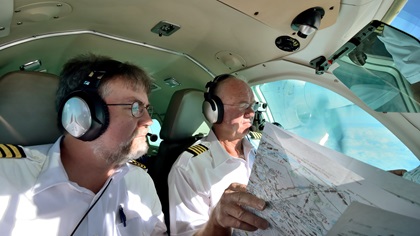
From Austria to Australia, and between Australia and Alaska, Laver and I wear captains’ uniforms. Appearances are important in these parts of the world, and that means pilots need to look like airline captains. Uniforms convey a sense of authority and purpose that proves very helpful in getting through customs and immigration. On our first day in pilot attire, Bucharest Control clears us on initial check-in all the way across Hungary—it must be the uniforms.
Fuelers not familiar with the MU–2 have to be coached. First the main tanks are filled; then the smaller, outer tanks; finally, tip tanks on each wing. The tips hold 90 gallons per side—that’s 612 pounds, so balance is important. Fill one tip halfway, about 50 gallons or 200 liters; the other tip can be filled completely, then the first tip is topped. Ladder placement’s critical; the airplane will lean significantly and a ladder in the wrong place will be expensive.
A high-frequency radio and position reports still are the order of the day in much of the world. The Garmin GTN 750 and GTN 650 in Laver’s panel make position reporting a breeze; with the flight plan screen displayed on the 650, distance and time to upcoming waypoints are continually displayed. We spend a remarkable amount of time in, above, and between clouds—and really miss the big-picture perspective that datalinked Nexrad radar images provide at home.
In most countries we visit, customs and immigration are in the airline terminal. Our handlers skillfully walk us through these mazes. Crews move to the front of any lines. Stops at out-of-the-way offices to file flight plans sometimes are required. “How could a person possibly do this himself?” Laver remarks after one especially fast experience. Clearing customs and immigration is uneventful everywhere except Australia, where we learn that we failed to provide the appropriate notice of arrival. The agents are professional and polite, and quickly determine our error was inadvertent. We’re sent on our way with a warning.
Memorable moments
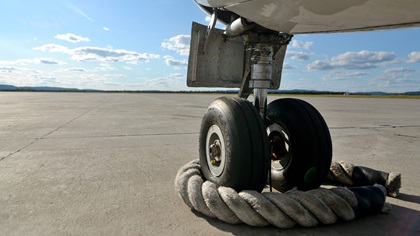
Arriving at Goose Bay, Laver is astonished by the view of Runway 8. “I’ve never landed at Goose Bay in good weather,” he confesses. Glaciers calve so many icebergs on Greenland’s east coast, bays look like bowls of ice cubes.
On the way from Ankara, Turkey, to Kuwait we track southeast, then turn right to enter Iraq’s airspace through a narrow corridor between Syria and Iran—guess where we encounter massive cumulus buildups? We circumnavigate them without causing any international incidents.
Birds are a problem in Mumbai, India, where we stop for fuel. Noise cannons make the airport sound—and smell—like the Fourth of July. I fuel while Laver re-files our flight plan; the Indian bureaucracy won’t accept BaseOps’ plan.
Approaching Banda Aceh’s Runway 17 we cross ribbons of white beach bordering turquoise waters, and swaths of prime waterfront real estate are swept nearly clean—grim evidence of a tsunami eight years ago that destroyed 80 percent of the city and claimed 250,000 lives.
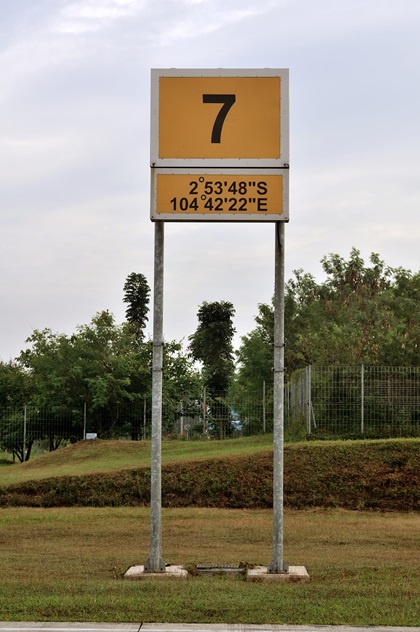
It’s monsoon season in Indonesia. There’s a dramatic squall line just east of the Banda Aceh airport as we depart after our tech stop. We can’t avoid the cell over the airport at Palembang, however; the approach is nearly to minimums in heavy rain and smooth air, but we’re soaked the instant we leave the airplane.
Overall, except for persistent headwinds, I’m amazed at how good the weather has been for us. We leave Japan less than a day before Tropical Storm Man-yi arrived, and minor volcanic eruptions in Japan and in Alaska turn out to be nothing more than mentions in our weather packages.
Heading for Japan
It’s nice to be wearing regular clothes again, and even nicer to have tailwinds en route to Australia’s Latrobe Valley Airport, where Laver soloed 45 years ago. He’ll spend a couple of days with his mother and brother, who meet us at the airport. Here I have my only day to myself of the trip; I do laundry, have lunch with members of the Latrobe Valley Aero Club, and explore.
Flying north again, valley floors resonate with the bright greens of spring as we cross the Great Dividing Range, mountains that run a quarter of the way up Australia’s east coast. We cross the resort area of Noosa Heads and its wide beaches as we begin our descent into Bundaberg, where Laver visits with David McKenzie, a friend from boarding school he has not seen since 1968. A veterinary surgeon who “runs sheep,” raising some 8,000 head; McKenzie flew in from Mildura in the Cessna Hawk XP he bought new.
Transiting the Great Barrier Reef, we enjoy an unwinding vista of reef after reef. At Horn Island, airport manager Mike Castrisos offers a ride to the ferry terminal—our hotel is on nearby Thursday Island. The next morning we’re back in uniform, waiting on the dock for the first boat of the day to Horn Island, when we’re approached by a customs officer. She explains that she can’t take the first ferry over, and proceeds to clear us out of Australia in the predawn darkness. A tech stop and two overnights get us to Nagoya, where we arrive just before noon on September 13.
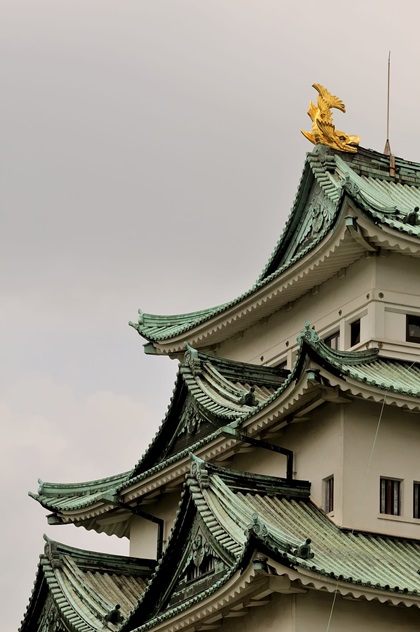
People here still love this twin turboprop. “You are a hero of Japan,” a fan writes Laver. And it’s a hero’s welcome we receive in Nagoya. Nearly 100 people wait, several waving Japanese, American, and even Australian flags. We’re greeted by a delegation from Mitsubishi Heavy Industries. People cluster around the MU–2’s data plate, and one man nearly climbs under the airplane, studying the landing gear.
We tour Mitsubishi’s aviation museum, which includes MU–2 serial number 501, Mitsubishi’s corporate aircraft for many years. It also features a World War II Zero restored from recovered wreckage, and a rocket-powered fighter based on the Messerschmitt Me 163 that never became operational. At another museum we see one of only three MU–2As ever built; its skinny cowlings house French-built Turbomeca Astazou engines that didn’t produce enough power for the airframe.
We spend the MU–2’s fiftieth anniversary touring Nagoya. Laver had considered flying a commemorative local flight today but ruled it out, in part because of high landing fees at Nagoya. And we’re ready for the home stretch, four long flying days home.
Time to head home
On our fuel stop at Russia’s Yuzhno-Sakhalinsk Airport, our weather packet’s depiction charts are hand-colored with pencil. Approaching Petropavlovsk-Kamchatsky, the vista of mountains surrounding a bay, silhouetted by the setting sun, is spectacular. We touch down on a washboard runway—common in this part of Russia, we’ve been told. It’s 9:45 p.m. local when we check into our hotel; we lost three hours to time change today, and we’ll lose four more tomorrow.
A helicopter pilot displays the camaraderie among aviators everywhere on our approach to Anadyr, Russia, when he transmits in broken English, “Significant wind shear.” He speaks in Russian with the controller, who repeats the advisory. Later the pilot adds, “Stops at runway.” Sure enough, a wicked wind shear on final disappears when crossing the threshold. It’s cold and windy here; our handler says the snow usually starts in September, but sometimes in August. “Maybe today,” ventures the immigration man.
An hour after takeoff we depart Russian airspace; jump the International Date Line from Monday afternoon to Sunday evening; and enter U.S. airspace. Over Nome, Alaska, the moon rises at our 2 o’clock as the sun slowly sets behind us. We’re cleared for a visual approach into Fairbanks—the first in weeks—and our Customs experience is painless.
Color paints the eastern sky early the next morning, and birch trees along the Tanana River are brilliant yellow. The rising sun slowly drizzles golden light from the tops of tall, snow-capped mountains to our south. Headwinds push our groundspeed down to 230 knots as the sun marches higher in the sky, accelerated by our relentless push across three more time zones. In Ketchikan we land, fuel, pay the bill, and take off again—in 24 minutes. Landing in Minot, North Dakota, after crossing southwestern Canada, we do not miss the customs and immigration routine.
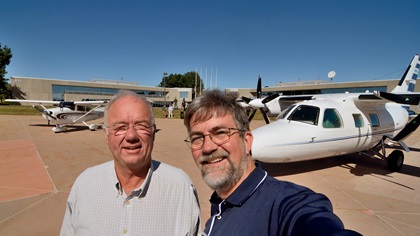
The last morning of our trip, we learn that N50ET’s nose gear was damaged accidentally when the airplane was moved overnight. However, the FBO had summoned a mechanic who replaced the sheared bolt and prepared a logbook entry documenting the repair. Climbing eastward, we watch a thin line of light along the eastern horizon grow taller and separate into colors. Around Fargo the sun’s disk breaks the horizon. Even better, we have a 10-knot tailwind.
In a few hours we touch down in Frederick, where a large group of my AOPA friends and coworkers—and my lovely wife, Janette—are waiting on the ramp. While it’s been a fantastic trip, it’s absolutely great to get home.
Epilogue
We averaged 271 knots across 26,568 nm and 98.1 flight hours. Laver’s journey began and ended in Aiken,so he logged two more legs and anadditional 907 nm. More than a month after our return, bills are trickling in through BaseOps and fuel supplier World Fuel, and final numbers remain at least a month away.
I’m impressed by the ease of the trip’s execution, and by how much is possible in a general aviation aircraft—especially a relatively modest one that few would consider a global traveler. Every day I am reminded of how good we have it here in the United States, as far as personal flying is concerned. The poverty around several airports, and the tsunami-cleared beachfronts in Banda Aceh, are disheartening. I will forever carry images of sights I’ve seen and people I’ve met on this trip, which would not have been possible without a GA aircraft.
Laver is unquestionably pleased by the demonstrated global capability of a 50-year-old design. Would he do it again? Perhaps, but not any time soon. “Next I think I would like to fly out west—in my Super Cub,” he says.
Email [email protected]
For more details of the trip and a scalable DeLorme tracking map, see the author’s blog: www.aopa.org/mu2


